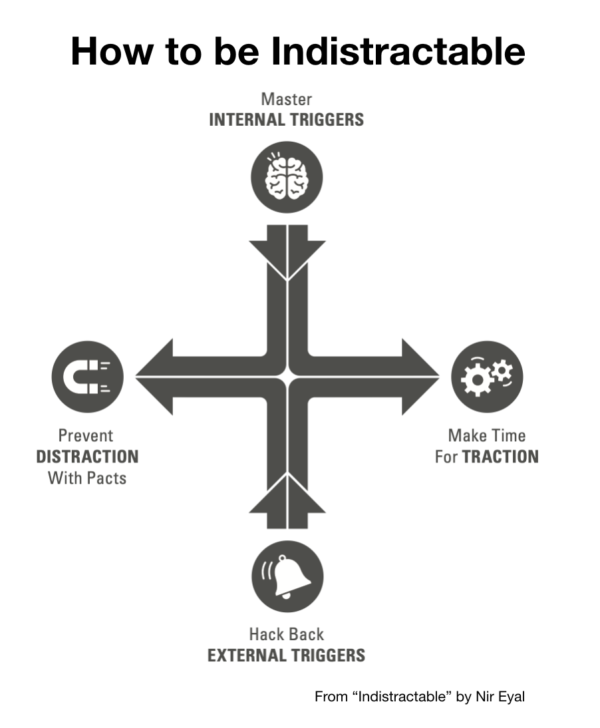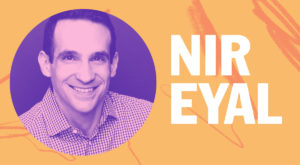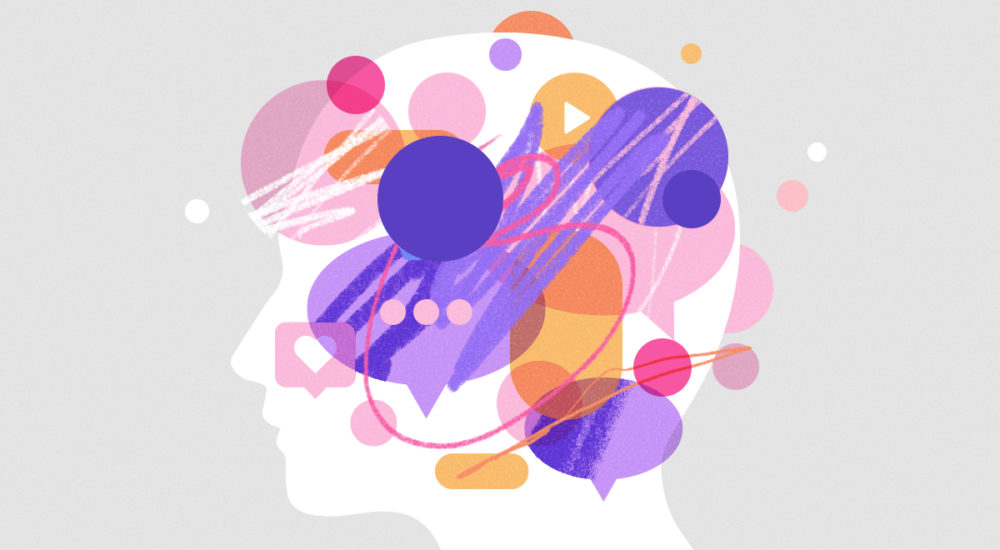Distractions tempt us at every turn, from an ever-growing library of Netflix titles to video games (Animal Crossing is my current vice) to all of the other far more tantalizing things we could be doing instead of doing what actually needs to be done. Is there any hope to focus on the things that matter in a world that wants us to do everything all the time?
Spoiler: the answer is yes.
Nir Eyal, avid Pocket user and author of Hooked: How to Build Habit-Forming Products and Indistractable: How to Control Your Attention and Choose Your Life, sat down with us to share his insights on how to beat distraction and stop feeling guilty about watching YouTube videos or playing Animal Crossing on your downtime.
How did you start using Pocket and what keeps you coming back?
Pocket features prominently in my book Indistractible. I think it’s a fantastic way to use “temptation bundling.” Temptation bundling is when we take something that we like to do and we bundle it with something we don’t really like to do, so for me listening to Pocket articles (I love the text-to-speech feature) is the way that I incentivize myself to go on a walk or to do exercise. I listen to articles while I do those things and it has a few benefits. It not only gets me outside (whether it’s exercising outside or indoors), but maybe even more beneficial is the fact that I don’t have to waste time reading articles online because I have a rule that I never read articles online. I only read articles in Pocket or listen to them in Pocket. So there’s a big time win there. I’ve been using Pocket for a very, very long time and I love it.
There’s a lot of information coming at all of us 24/7 these days. How are you managing the distractions to keep yourself focused? On the other side of that question, how are you making time to stay on top of information and when do you stop?
It’s really important to understand the difference between traction and distraction. The opposite of distraction is not focus. This is a really important point that a lot of people don’t get because they think that the opposite of distraction is focus. It’s not. The opposite of distraction is traction. The difference between traction and distraction is one word, and that’s intent.
There’s nothing wrong with enjoying Facebook or Instagram or YouTube videos (don’t believe that rubbish that it’s addicting you and hijacking your brain). I wrote the book Hooked and I can tell you the techniques that these companies use are good, but they’re not that good. We’re not powerless. We are absolutely more powerful than the tech companies and we can put these technologies in their place by using other technologies to make sure we can do what we really want to do.
By time shifting when I consume content, that’s a great example, right? So reading the New York Times when I say I will–wonderful. Reading the New York Times when I’m fearful, when I’m anxious, when I’m stressed and I planned to do one thing and now I’m checking the New York Times instead–horrible right? Anything can be traction, anything can be distraction based on intent.
What we have to do is to turn our values into time by actually having time in our schedule to do whatever it is we say we’re going to do. If that’s going online and reading articles, then absolutely. I have time in my schedule after lunch everyday for 1 hour to check on the news. I have a list of different websites I visit to keep myself updated and you know these days it’s very important that we stay up to date on what’s going on.
So it’s all about scheduling that time and consuming content, consuming media with intent.
What are your favorite apps for keeping you focused?
There’s all kinds of tools we can use these days to help us become indistractible. We know certainly that many technology companies are hacking our attention, but there’s no reason we can’t hack back.
On my computer I use an app called SelfControl that limits my access to certain websites I don’t want to use while I’m doing focused work. While I’m writing (writing is really hard), I don’t want to be tempted to go check Facebook or Google or the news and I don’t have to be tempted by those things because a product like SelfControl blocks those distractions from me so I can’t get to them during those set periods of time.
Forest is a wonderful, very cute app that helps me defend from having to pick up my phone when I’m feeling distractible. Forest prevents you from checking your phone with this disincentive of a little virtual tree that if you pick up your phone, the virtual tree dies.
Some people have been advocating for a return to simplicity and so many of us have been forced into it now. What are your thoughts on that and what positive changes or habits are you hoping continue after the pandemic is over?
I think there’s a lot of positive things that will come out of the way we work these days. I think that one thing I’m very happy to see is that people are being much more intentional about the time they spend with the people they love. The fact that we are now scheduling time for our important relationships in a way we didn’t before, I really hope that continues.
Prior to this crisis, there was an epidemic of loneliness. I’ll be really interested to see what happens after this crisis. One theory is that we’ll become more lonely. I actually think people are going to become in some ways less lonely if they have access to technology, because now for the first time we’re making time for our relationships, which is a big part of what I talk about in my book. It’s about having that time in our calendar for the people we love so it’s not about making them get the scraps of time that are leftover, which is how most of us lived our life before this crisis. Today we schedule time for those Zoom calls and that’s something that I really hope continues.
You have some great insights on your website around a wide range of topics from time management to creativity. Motivation, in particular, caught my eye as so many of us are working from home now and finding it hard to motivate without being able to leave the house. What do you recommend in order to stay motivated while not having the usual external forcing functions in our lives?
It’s really about turning your values into time. Many of us are literally going crazy these days because the constraints that used to guide our day are gone. The schedule of having to wake up, feed your kids, get them to school, sit in traffic, go to work, etc. Those things gave us constraints and constraints actually help us be our best self. We don’t typically think of that because we think constraints are imposed upon us, but that’s not necessarily the case–we can impose our own constraints.
Many people don’t even remember what day of the week it is and that’s maddening. So what we have to do is decide in advance how we want to spend our time and whatever way you want to spend your time is fine. It’s not up to me or anyone else to tell you what your values should be. What I do want you to do is to turn those values into time by having a place on your schedule for whatever it is you want to do. That is the only way we can tell the difference between traction and distraction, because remember you can’t call something a distraction unless you know what it distracted you from.
What does a typical day look like for you now and how does that compare to before we all went into quarantine?
This is not too terribly different from what my life used to look like before Coronavirus. I’ve worked from home for many years and my daughter has been homeschooled for about five years now and so this isn’t too different for me. When I first started working from home it was a very big change and it took a lot of adjustment (now we’ve had a lot of practice). A big reason why I wrote Indistractible is because I found the change to be so jarring and so difficult.
The metric of success is not what you accomplish, it’s not about to-do lists. To-do lists are terrible, I hate to-do lists. They are degrading people’s productivity. Instead what you want to do is use a timebox calendar. My day is timeboxed. I know exactly what I’m going to do every day because I decide that in advance.
Many of us are quarantining at home with kids, which can be challenging if you also have to work. Are there any tips you could recommend for working parents?
External triggers are the pings, the dings, the rings, the things in our outside environment that can lead us towards distraction. Now kids, of course, can be external triggers. It’s not just about your phone and your computer, but it can be your little one asking mommy or daddy for some help when you want to focus. So what do you do?
Here’s what you do. Go around your house and you look for the silliest hat you have, this is my wife’s.

We call this the “concentration crown.” Every time daddy is wearing the concentration crown, that blocks the external trigger of my daughter interrupting me because she knows daddy is wearing the concentration crown and that means that I’m not to be interrupted now.
I don’t wear that all day and she knows of course she can have access to me when we have time together. That’s of course planned in advance, so she knows okay just wait a bit and daddy’s going to be with you. To interrupt that external trigger of a child or a spouse or significant other interrupting you, using a concentration crown is very, very effective.
You spent years working in the video game industry. What’s your take on the way Animal Crossing has become such a big phenomenon lately?
Any of these games I think are wonderful, as long as they’re used with intent. I think for many people they are looking for these diversions. These are not necessarily distractions. A diversion is simply a refocusing of attention. So that’s a refocusing of attention on your phone or playing a video game or watching Netflix. There’s nothing wrong with it. It can be a wonderful way to relieve some pressure and enjoy diverting attention, as long as it’s not a distraction. A distraction by definition is any action that pulls you away from what you plan to do, but if you plan to play Animal Crossing great, that’s traction. Not distraction.
How do you think your past professional experience has shaped your perspective on distraction?
My first book, Hooked, was about how to build habit-forming products. My work was all about looking at the world’s most habit-forming products: Facebook, Twitter, Instagram, WhatsApp, video game companies; to understand what makes them so sticky so that the rest of us could build products and services that get people hooked to healthy habits in their lives.
I didn’t write Hooked for Facebook and YouTube–they’ve known those techniques for years. What I wanted to do was to democratize those techniques so that companies like Fitbod can get people hooked to exercise, Kahoot! uses the Hooked model to get kids hooked on learning, The New York Times (one of my clients) uses the Hooked model to keep people engaged with the news. There’s there’s lots of ways we can use the Hooked model to build healthy habits.
The flip side is that I also understand the Achilles heel. So who understands how technology is built to hook us better than the person who wrote the book Hooked. That’s why I thought I was supremely qualified to write the book because I understand the psychology, the deeper reason why products and services bring us back.
Sometimes it serves us and it’s wonderful, but sometimes it feels like we are serving the technology. That’s why I wanted to expose these methods so we could learn from them and make sure technology serves us as opposed to us serving it, but without having an anti-tech bias. I don’t believe this rubbish that technology is hijacking your brain. It’s silly and it’s not practical. We should use these technologies. These Technologies improve our lives so we don’t want to be elitist and say “oh, you know what you do with your time that’s a big waste, but what I do with my time, that’s somehow okay.” No, anything you want to do with your time as long as you do it with intent is traction not distraction. That includes video games, social media and YouTube videos–whatever it is you want to do with your time. It’s not the technology that’s the problem and I think we need to get that message out there because you know many people like to blame technology and it actually makes things worse because it’s called learned helplessness. When we think that something is doing it to us, then we feel powerless and we don’t do anything about it. So thinking that technology hijacks your brain and addicts everyone is not true. It’s not scientific and it leads to learned helplessness. So I want to teach empowerment, not this attitude of just blaming and shaming.
What are your top five tips for beating distraction?
Let’s talk about the four key strategies to becoming indistractible:

Step 1: Master the internal triggers. All that’s about is these uncomfortable emotional states that lead us towards distraction. The root cause of all procrastination, all distraction is always about the desire to escape discomfort. If we don’t deal with those internal triggers first, we will always be distracted by one thing or another.
Step 2: Make time for traction. We talked about that a little bit, about planning out your day and making sure you use a timebox calendar. You can’t call something a distraction unless you know what it’s distracting you from.
Step 3: Hack back the external triggers. Whether it’s your phone, your computer, your kids, your boss, your co-workers, meetings, emails. We have to make sure that we systematically remove these external triggers that don’t serve us. Remember, external triggers are the things in our environment, internal triggers are what’s in our head.
Step 4: Prevent distraction with pacts. This is where we decide to use what’s called a pre-commitment. We take steps today to ensure that we don’t get distracted tomorrow. There’s three types of pacts. We have what we call “price pact” where there’s some kind of disincentive (like a monetary disincentive) to getting distracted. Then we have what’s called an “effort pact,” where there’s some kind of friction, a bit of work between you and something you don’t want to do. Finally there’s an “identity pact” and this is the most powerful of the three. This is where we start using our identity to help us become who we want to be. There are many studies from the psychology of religion around how having a moniker, having a noun that describes you makes you much more likely to do what you say you’re going to do. Just like a vegetarian doesn’t say “Hmm, should I have bacon for breakfast this morning?” No, they are a vegetarian, it’s who they are. The decision has been made in advance. So they don’t have to use any willpower or self-control. This is why the book is called Indistractible. This is a movement of people who say I don’t want my life to be controlled and dictated and manipulated by others. I choose how I control my attention. I choose how I spend my time in my life. I am indistractible.
If everyone just did one thing to start building healthful habits in their lives, what would it be?
I think it is to adopt this identity to stop blaming others, to stop shaming yourself and to realize that blaming and shaming doesn’t work. What works is claiming. We don’t want to be blamers, we don’t want to be shamers, we want to be claimers. Claimers claim responsibility. Not for their feelings, you cannot control your feelings, that’s out of your control. You cannot control your urges. What you can control is how you respond to your urges, to your feelings. That’s what matters, that’s where our humanity lies is in the distance between stimulus and response, as Rollo May said.
What we have to do is understand that we can take responsibility. Hence this idea of how we respond to these sensations. We can take responsibility for what we do when we respond to these internal triggers, to these uncomfortable emotional states and that makes all the difference in the world. So it’s really about understanding that the antidote to impulsiveness is forethought. You don’t need a lot of self-control. You don’t need a lot of willpower. What you need is a system in place, these four simple strategies anyone can use to become indistractible, that is how we do it.

Nir Eyal | Speaker & Thought Leader
Nir Eyal writes, consults, and teaches about the intersection of psychology, technology, and business. The M.I.T. Technology Review dubbed Nir, “The Prophet of Habit-Forming Technology.”
Nir founded two tech companies since 2003 and has taught at the Stanford Graduate School of Business and the Hasso Plattner Institute of Design at Stanford.
He is the author of two bestselling books, Hooked: How to Build Habit-Forming Products and Indistractable: How to Control Your Attention and Choose Your Life.
In addition to blogging at NirAndFar.com, Nir’s writing has been featured in The New York Times, The Harvard Business Review, Time Magazine, and Psychology Today.
IRL: Digital Overload
What does it mean to grow up online? We investigate how the www is changing our bodies and our brains. A college student shares his experience at rehab for Internet addiction. Bestselling author Nir Eyal breaks down what apps borrow from gambling technology. Writer Heather Schwedel talks about taking a cue from Kanye and breaking up with Twitter. And blogger Joshua Cousins talks about the Internet as a lifeline, in the wake of recent natural disasters. IRL is an original podcast from Firefox.
